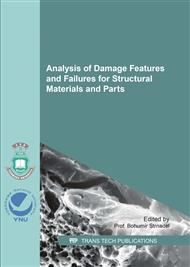[1]
S. Nishida, Fatigue fracture of welded structure and factors related to its fatigue strength (1), Quarterly Journal of the Japan Welding Society. 62 (1993) 595-598. (in Japanese).
DOI: 10.2207/qjjws1943.62.595
Google Scholar
[2]
Y. Martin and K. H. Wickramasinghe, Magnetic imaging by force microscopy, with 1000 Å resolution, Appl Phys Lett. 50 (1987) 1455-1457.
DOI: 10.1063/1.97800
Google Scholar
[3]
A. M. Chang, H. D. Hallen, L. Harriot, H. F. Hess, H. L. Loa, J. Kao, R. E. Miller and T. Y. Chang, Scanning Hall probe microscopy, Appl Phys Lett. 61 (1992) 1974-(1976).
DOI: 10.1063/1.108334
Google Scholar
[4]
A. Oral, S. J. Bending and M. Henini, Scanning Hall probe microscopy of superconductors and magnetic materials, J. Vac. Sci. Technol. B. 14 (1996) 1202-1205.
DOI: 10.1116/1.588514
Google Scholar
[5]
A. Sandhu, H. Masuda, A. Oral, S. J. Bending, A. Yamada and M. Konagai, Room temperature scanning Hall probe microscopy using GaAs/AlGaAs and Bi micro-hall probes, Ultramicroscopy. 91 (2002) 97-101.
DOI: 10.1016/s0304-3991(02)00087-6
Google Scholar
[6]
K. Kida, H. Tanabe and H. Okano, Changes in magnetic flux density around fatigue crack tips, Fatigue & Fracture of Engineering Materials & Structures. 32 (2009) 180-188.
DOI: 10.1111/j.1460-2695.2008.01307.x
Google Scholar
[7]
K. Kida, E. C. Santos, T. Honda, H. Koike and J. A. Rozwadowska, Observation of magnetic flux density around fatigue crack tips in bearing steel using a SHPM with a three-dimensional small-gap probe, International Journal of Fatigue. 39 (2012).
DOI: 10.1016/j.ijfatigue.2011.05.013
Google Scholar
[8]
K. Kida, E. C. Santos, M. Uryu, T. Honda, J. A. Rozwadowska and K. Saruwatari, Changes in magnetic field intensities around fatigue crack tips of medium carbon low alloy steel (S45C, JIS), International Journal of Fatigue. 56 (2013) 33-41.
DOI: 10.1016/j.ijfatigue.2013.07.015
Google Scholar
[9]
K. Kida, M. Uryu, T. Honda, E. C. Santos and K. Saruwatari, Three-Dimensional Observation of Magnetic Fields in Alloy Tool Steel under Spherical Hertzian Contact, Materials Research Innovations. 18/Issue Supplement 1 (2014) 71-75.
DOI: 10.1179/1432891713z.000000000358
Google Scholar
[10]
K. Kida, T. Honda, E. C. Santos, K. Saruwatari, M. Uryu, K. Houri, H. Tanabe and K. Kanemasu, Three-dimensional Magnetic Microscopy of Early Stage Fatigue in WMZ of Low Carbon Steel Plates (JIS-SS400), Materials Research Innovations. 18/Issue Supplement 1 (2014).
DOI: 10.1179/1432891713z.000000000357
Google Scholar
[11]
K. Kida, M. Uryu, T. Honda, T. Shimoji, E. C. Santos and K. Saruwatari, Changes in magnetic fields in tool steel (SKS93, JIS) under single tensile load, Applied Mechanics and Materials. 307 (2013) 144-148.
DOI: 10.4028/www.scientific.net/amm.307.144
Google Scholar
[12]
E.J. Pavlina and C.J. Van Tyne, Correlation of Yield Strength and Tensile Strength with Hardness for Steels, ASM International, Journal of Materials Engineering and Performance. 17 (2008) 888-893.
DOI: 10.1007/s11665-008-9225-5
Google Scholar
[13]
K. Kida, M. Ishida, M. Furuse, K. Mizobe and E. C. Santos, Effect of plastic deformation on magnetic fields around fatigue crack tips of carbon tool steel (JIS, SKS93), International Journal of Fatigue. 88 (2016) 156-165.
DOI: 10.1016/j.ijfatigue.2016.03.022
Google Scholar


